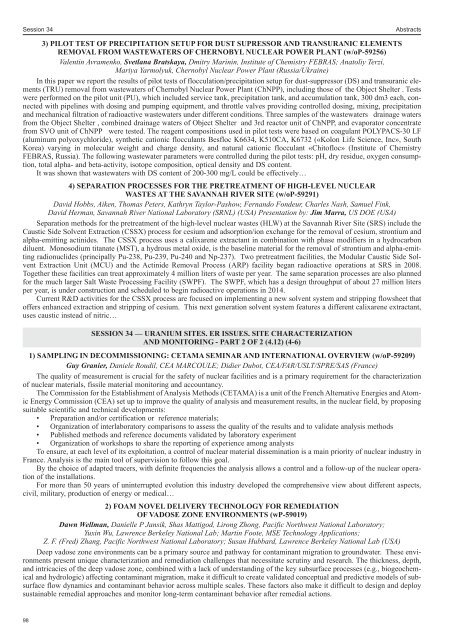ICEM11 Final Program 9.7.11pm_ICEM07 Final Program ... - Events
ICEM11 Final Program 9.7.11pm_ICEM07 Final Program ... - Events
ICEM11 Final Program 9.7.11pm_ICEM07 Final Program ... - Events
Create successful ePaper yourself
Turn your PDF publications into a flip-book with our unique Google optimized e-Paper software.
Session 34 Abstracts<br />
3) PILOT TEST OF PRECIPITATION SETUP FOR DUST SUPRESSOR AND TRANSURANIC ELEMENTS<br />
REMOVAL FROM WASTEWATERS OF CHERNOBYL NUCLEAR POWER PLANT (w/oP-59256)<br />
Valentin Avramenko, Svetlana Bratskaya, Dmitry Marinin, Institute of Chemistry FEBRAS; Anatoliy Terzi,<br />
Mariya Yarmolyuk, Chernobyl Nuclear Power Plant (Russia/Ukraine)<br />
In this paper we report the results of pilot tests of flocculation/precipitation setup for dust-suppressor (DS) and transuranic elements<br />
(TRU) removal from wastewaters of Chernobyl Nuclear Power Plant (ChNPP), including those of the Object Shelter . Tests<br />
were performed on the pilot unit (PU), which included service tank, precipitation tank, and accumulation tank, 300 dm3 each, connected<br />
with pipelines with dosing and pumping equipment, and throttle valves providing controlled dosing, mixing, precipitation<br />
and mechanical filtration of radioactive wastewaters under different conditions. Three samples of the wastewaters drainage waters<br />
from the Object Shelter , combined drainage waters of Object Shelter and 3rd reactor unit of ChNPP, and evaporator concentrate<br />
from SVO unit of ChNPP were tested. The reagent compositions used in pilot tests were based on coagulant POLYPACS-30 LF<br />
(aluminum polyoxychloride), synthetic cationic flocculants Besfloc K6634, K510CA, K6732 («Kolon Life Science, Inc», South<br />
Korea) varying in molecular weight and charge density, and natural cationic flocculant «Chitofloc» (Institute of Chemistry<br />
FEBRAS, Russia). The following wastewater parameters were controlled during the pilot tests: pH, dry residue, oxygen consumption,<br />
total alpha- and beta-activity, isotope composition, optical density and DS content.<br />
It was shown that wastewaters with DS content of 200-300 mg/L could be effectively…<br />
4) SEPARATION PROCESSES FOR THE PRETREATMENT OF HIGH-LEVEL NUCLEAR<br />
WASTES AT THE SAVANNAH RIVER SITE (w/oP-59291)<br />
David Hobbs, Aiken, Thomas Peters, Kathryn Taylor-Pashow, Fernando Fondeur, Charles Nash, Samuel Fink,<br />
David Herman, Savannah River National Laboratory (SRNL) (USA) Presentation by: Jim Marra, US DOE (USA)<br />
Separation methods for the pretreatment of the high-level nuclear wastes (HLW) at the Savannah River Site (SRS) include the<br />
Caustic Side Solvent Extraction (CSSX) process for cesium and adsorption/ion exchange for the removal of cesium, strontium and<br />
alpha-emitting actinides. The CSSX process uses a calixarene extractant in combination with phase modifiers in a hydrocarbon<br />
diluent. Monosodium titanate (MST), a hydrous metal oxide, is the baseline material for the removal of strontium and alpha-emitting<br />
radionuclides (principally Pu-238, Pu-239, Pu-240 and Np-237). Two pretreatment facilities, the Modular Caustic Side Solvent<br />
Extraction Unit (MCU) and the Actinide Removal Process (ARP) facility began radioactive operations at SRS in 2008.<br />
Together these facilities can treat approximately 4 million liters of waste per year. The same separation processes are also planned<br />
for the much larger Salt Waste Processing Facility (SWPF). The SWPF, which has a design throughput of about 27 million liters<br />
per year, is under construction and scheduled to begin radioactive operations in 2014.<br />
Current R&D activities for the CSSX process are focused on implementing a new solvent system and stripping flowsheet that<br />
offers enhanced extraction and stripping of cesium. This next generation solvent system features a different calixarene extractant,<br />
uses caustic instead of nitric…<br />
SESSION 34 — URANIUM SITES, ER ISSUES, SITE CHARACTERIZATION<br />
AND MONITORING - PART 2 OF 2 (4.12) (4-6)<br />
1) SAMPLING IN DECOMMISSIONING: CETAMA SEMINAR AND INTERNATIONAL OVERVIEW (w/oP-59209)<br />
Guy Granier, Daniele Roudil, CEA MARCOULE; Didier Dubot, CEA/FAR/USLT/SPRE/SAS (France)<br />
The quality of measurement is crucial for the safety of nuclear facilities and is a primary requirement for the characterization<br />
of nuclear materials, fissile material monitoring and accountancy.<br />
The Commission for the Establishment of Analysis Methods (CETAMA) is a unit of the French Alternative Energies and Atomic<br />
Energy Commission (CEA) set up to improve the quality of analysis and measurement results, in the nuclear field, by proposing<br />
suitable scientific and technical developments:<br />
• Preparation and/or certification or reference materials;<br />
• Organization of interlaboratory comparisons to assess the quality of the results and to validate analysis methods<br />
• Published methods and reference documents validated by laboratory experiment<br />
• Organization of workshops to share the reporting of experience among analysts<br />
To ensure, at each level of its exploitation, a control of nuclear material dissemination is a main priority of nuclear industry in<br />
France. Analysis is the main tool of supervision to follow this goal.<br />
By the choice of adapted tracers, with definite frequencies the analysis allows a control and a follow-up of the nuclear operation<br />
of the installations.<br />
For more than 50 years of uninterrupted evolution this industry developed the comprehensive view about different aspects,<br />
civil, military, production of energy or medical…<br />
2) FOAM NOVEL DELIVERY TECHNOLOGY FOR REMEDIATION<br />
OF VADOSE ZONE ENVIRONMENTS (wP-59019)<br />
Dawn Wellman, Danielle P Jansik, Shas Mattigod, Lirong Zhong, Pacific Northwest National Laboratory;<br />
Yuxin Wu, Lawrence Berkeley National Lab; Martin Foote, MSE Technology Applications;<br />
Z. F. (Fred) Zhang, Pacific Northwest National Laboratory; Susan Hubbard, Lawrence Berkeley National Lab (USA)<br />
Deep vadose zone environments can be a primary source and pathway for contaminant migration to groundwater. These environments<br />
present unique characterization and remediation challenges that necessitate scrutiny and research. The thickness, depth,<br />
and intricacies of the deep vadose zone, combined with a lack of understanding of the key subsurface processes (e.g., biogeochemical<br />
and hydrologic) affecting contaminant migration, make it difficult to create validated conceptual and predictive models of subsurface<br />
flow dynamics and contaminant behavior across multiple scales. These factors also make it difficult to design and deploy<br />
sustainable remedial approaches and monitor long-term contaminant behavior after remedial actions.<br />
98
















